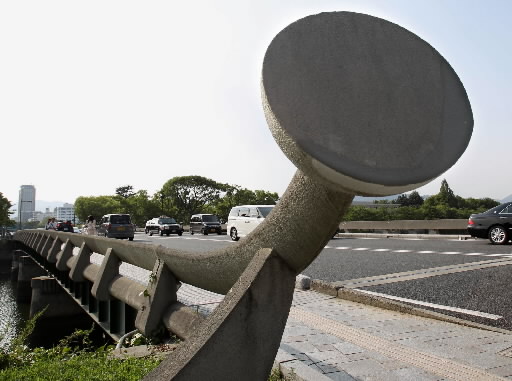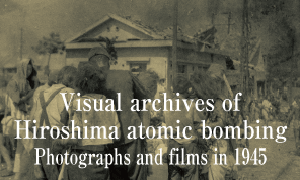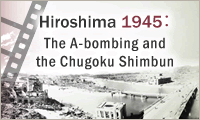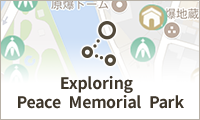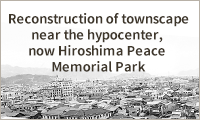Opinion: The bridge that Noguchi built
Aug. 14, 2013
A spot that conveys the spirit behind the city’s rebuilding
by Naoki Harada, Editorial Writer
Even after August 6, many people come to Hiroshima to offer prayers for those who died in the atomic bombing. On the Peace Bridge I often pass people who are headed to Peace Memorial Park.
A particular photo related to the bridge comes to mind. The photo, which was taken more than 50 years ago, shows smiling children straddling the bridge’s railings. Looking at the picture, you can sense the spirit behind the city’s rebuilding. The photo attests to the way in which the bridge symbolized the city’s renaissance.
Modeled on the sun and titled “To Live,” the bridge is paired with the western Peace Bridge, which symbolizes a boat to the other world. Sixty-one years have passed since the two bridges were completed. Their unconventional designs originally sparked controversy, but ultimately the bridges boosted the spirits of the people of Hiroshima.
But, perhaps because people have grown accustomed to them over the years, or perhaps because they got lost amid the backdrop of the big city, there is not much interest in the bridges now. And, unfortunately, it seems that few people are aware of their history.
The railings of the two bridges were designed by the internationally known sculptor Isamu Noguchi (1904-1988).
An exhibition focusing on Noguchi titled “Art Arch Hiroshima 2013” is currently being held in the city. The first joint undertaking of the city’s three art museums, both private and public, the exhibition allows visitors to be exposed to the real Noguchi and gives them an opportunity to learn more about the Peace Bridges.
At the Hiroshima City Museum of Contemporary Art, visitors can see letters written by Noguchi at the time he was designing the railings as well as models he made for some of his works, including one of a “bell tower for Hiroshima.” The Hiroshima Museum of Art is also featuring artists who influenced Noguchi. The Hiroshima Prefectural Art Museum is displaying works by fashion designer and Hiroshima native Issey Miyake, with whom Noguchi was acquainted.
As a Japanese-American, Noguchi had a long-standing interest in Japan. Visitors to the exhibition will sense the sort of person Noguchi was and his marvelous sense of design.
During the war, Noguchi voluntarily entered an internment camp for Japanese-Americans. After the war, he came to Japan, where he studied pottery and tried his hand at landscape gardening. In later years he said he wanted Hiroshima to have a sense of a city “living strongly for the future.” When he returned to Hiroshima he gently stroked the railings of the bridge as if they were his children. Noguchi was an artist who devoted himself to Hiroshima’s recovery, and as such his story needs to be told more often.
For about 20 years the bridge has been the subject of debate in relation to urban planning because it has aged considerably and is too narrow for the volume of vehicular and pedestrian traffic it carries. Moving the current bridge and then building a new one has been proposed.
Now there is a plan to build a pedestrian bridge parallel to the Peace Bridge. A plan that will ensure pedestrians’ safety while preserving the original bridge is preferable. Even if the bridge is replaced at some time in the future, its symbolic railings must be preserved.
The city also plans to remove the paint that was applied during a restoration effort 30 years ago. This will reveal the original surface of the railings and present a good opportunity to reconsider the significance of the bridge.
The atomic bomb survivors are aging, and the buildings that survived the A-bombing and other vivid reminders of that day are disappearing. When considering how to pass on the experiences and memories of the A-bombing, preserving visible reminders would seem to be very meaningful.
Both the Peace Bridge and Peace Memorial Park, which was designed by Kenzo Tange, were built under the provisions of the Hiroshima Peace Memorial City Construction Act and are surely one legacy of the beginnings of the city’s recovery.
These spots have the power to tell of the atomic bombing.
Noguchi’s unrealized design for a memorial for the victims of Hiroshima’s A-bombing was another important task he tackled. Like the Peace Bridge, it is another of his works that can be said to “span” Hiroshima. Its two-layered structure features an arch-like shape above ground and a vault below to hold the names of those who died in the bombing. The model on display at the Museum of Contemporary Art is 1:5 scale, but the black stone has an overwhelming presence and imparts an impression of solemnity.
I can’t help but feel that if the memorial were to be built as a monument somewhere in the vicinity of Peace Memorial Park, the power of the spot would be doubled or tripled when combined with the bridge.
(Originally published on August 8, 2013)
by Naoki Harada, Editorial Writer
Even after August 6, many people come to Hiroshima to offer prayers for those who died in the atomic bombing. On the Peace Bridge I often pass people who are headed to Peace Memorial Park.
A particular photo related to the bridge comes to mind. The photo, which was taken more than 50 years ago, shows smiling children straddling the bridge’s railings. Looking at the picture, you can sense the spirit behind the city’s rebuilding. The photo attests to the way in which the bridge symbolized the city’s renaissance.
Modeled on the sun and titled “To Live,” the bridge is paired with the western Peace Bridge, which symbolizes a boat to the other world. Sixty-one years have passed since the two bridges were completed. Their unconventional designs originally sparked controversy, but ultimately the bridges boosted the spirits of the people of Hiroshima.
But, perhaps because people have grown accustomed to them over the years, or perhaps because they got lost amid the backdrop of the big city, there is not much interest in the bridges now. And, unfortunately, it seems that few people are aware of their history.
The railings of the two bridges were designed by the internationally known sculptor Isamu Noguchi (1904-1988).
An exhibition focusing on Noguchi titled “Art Arch Hiroshima 2013” is currently being held in the city. The first joint undertaking of the city’s three art museums, both private and public, the exhibition allows visitors to be exposed to the real Noguchi and gives them an opportunity to learn more about the Peace Bridges.
At the Hiroshima City Museum of Contemporary Art, visitors can see letters written by Noguchi at the time he was designing the railings as well as models he made for some of his works, including one of a “bell tower for Hiroshima.” The Hiroshima Museum of Art is also featuring artists who influenced Noguchi. The Hiroshima Prefectural Art Museum is displaying works by fashion designer and Hiroshima native Issey Miyake, with whom Noguchi was acquainted.
As a Japanese-American, Noguchi had a long-standing interest in Japan. Visitors to the exhibition will sense the sort of person Noguchi was and his marvelous sense of design.
During the war, Noguchi voluntarily entered an internment camp for Japanese-Americans. After the war, he came to Japan, where he studied pottery and tried his hand at landscape gardening. In later years he said he wanted Hiroshima to have a sense of a city “living strongly for the future.” When he returned to Hiroshima he gently stroked the railings of the bridge as if they were his children. Noguchi was an artist who devoted himself to Hiroshima’s recovery, and as such his story needs to be told more often.
For about 20 years the bridge has been the subject of debate in relation to urban planning because it has aged considerably and is too narrow for the volume of vehicular and pedestrian traffic it carries. Moving the current bridge and then building a new one has been proposed.
Now there is a plan to build a pedestrian bridge parallel to the Peace Bridge. A plan that will ensure pedestrians’ safety while preserving the original bridge is preferable. Even if the bridge is replaced at some time in the future, its symbolic railings must be preserved.
The city also plans to remove the paint that was applied during a restoration effort 30 years ago. This will reveal the original surface of the railings and present a good opportunity to reconsider the significance of the bridge.
The atomic bomb survivors are aging, and the buildings that survived the A-bombing and other vivid reminders of that day are disappearing. When considering how to pass on the experiences and memories of the A-bombing, preserving visible reminders would seem to be very meaningful.
Both the Peace Bridge and Peace Memorial Park, which was designed by Kenzo Tange, were built under the provisions of the Hiroshima Peace Memorial City Construction Act and are surely one legacy of the beginnings of the city’s recovery.
These spots have the power to tell of the atomic bombing.
Noguchi’s unrealized design for a memorial for the victims of Hiroshima’s A-bombing was another important task he tackled. Like the Peace Bridge, it is another of his works that can be said to “span” Hiroshima. Its two-layered structure features an arch-like shape above ground and a vault below to hold the names of those who died in the bombing. The model on display at the Museum of Contemporary Art is 1:5 scale, but the black stone has an overwhelming presence and imparts an impression of solemnity.
I can’t help but feel that if the memorial were to be built as a monument somewhere in the vicinity of Peace Memorial Park, the power of the spot would be doubled or tripled when combined with the bridge.
(Originally published on August 8, 2013)

